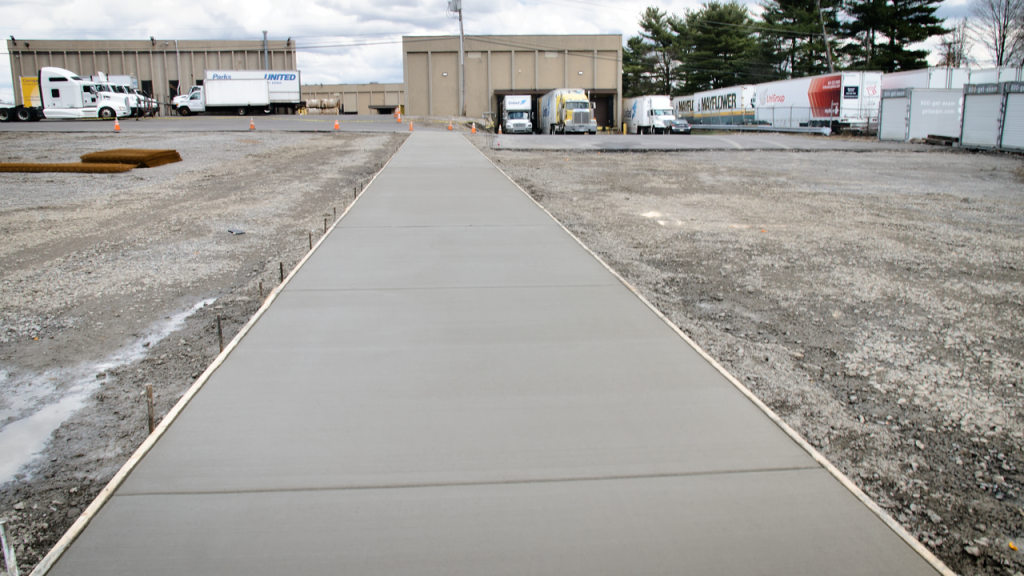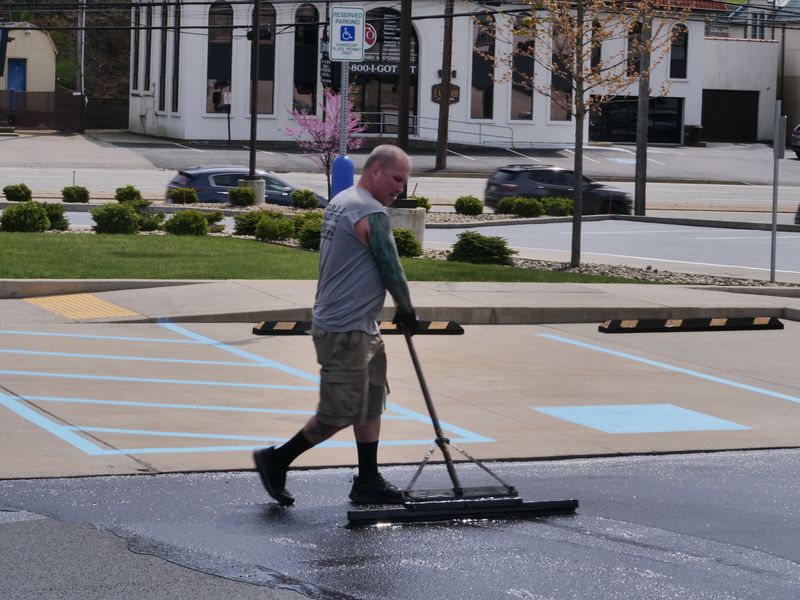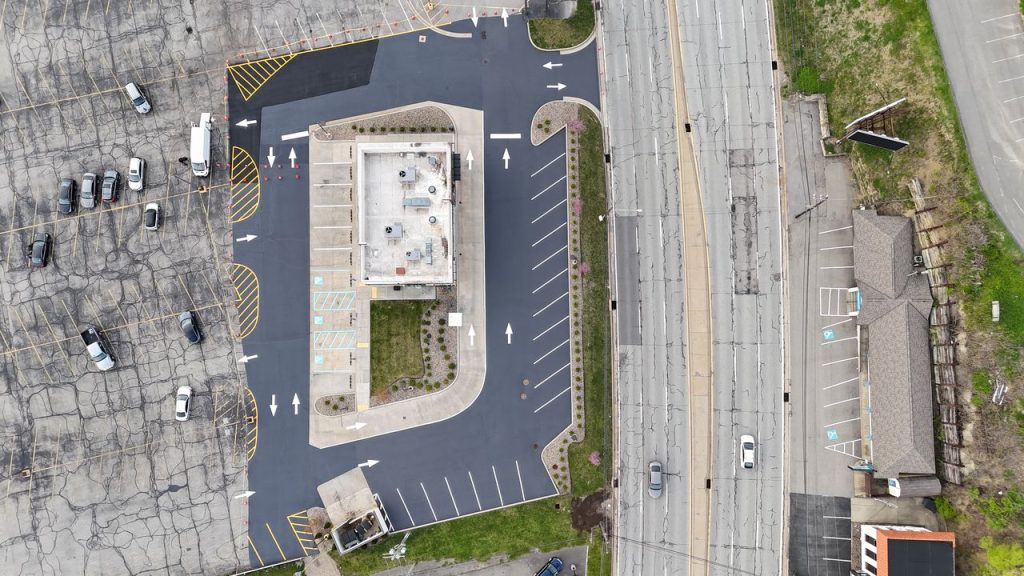When you pull into a business and see a smooth, jet-black parking lot with crisp stripes, you probably don’t think twice about it. But the truth is that the sealcoat on that lot is quietly telling you a story about how much the owner cares about first impressions, safety, and property value. A well-maintained commercial parking lot is like a handshake. It says you mean business before customers even walk through your doors.
Sealcoating is one of the simplest yet most overlooked ways to keep that handshake strong. If you run or manage a commercial property, understanding how often to sealcoat your parking lot is not just a matter of appearance. It’s about saving thousands in repairs, extending the life of your pavement, and ensuring safety for everyone who drives or walks across it.
Why Sealcoating Matters for Commercial Lots
Sealcoating is a protective layer applied over asphalt to shield it from weather, vehicle fluids, and everyday wear. In climates with heavy rain, snow, or summer heat, untreated asphalt can fade, crack, and weaken much faster. Over time, this leads to potholes, uneven surfaces, and costly resurfacing projects.
A good sealcoat acts like sunscreen for your pavement. It blocks UV rays, prevents water from seeping into small cracks, and keeps oil and gas spills from eating away at the asphalt binder.
The General Rule for Sealcoating Frequency
Most commercial parking lots need sealcoating every two to three years. But that’s just a starting point. The real answer depends on factors like traffic volume, local climate, and the quality of the last application. A high-traffic shopping center in Pittsburgh will wear faster than a small office lot in a mild climate.
Factors That Influence Your Commercial Parking Lot Sealcoat Schedule: A Detailed Look
Determining the optimal time to sealcoat your asphalt pavement is crucial for maximizing its lifespan and minimizing long-term repair costs. Here’s a more in-depth examination of the key factors that should influence your sealcoating schedule:
1. Traffic Load: The Impact of Volume and Vehicle Type
The amount and type of traffic that your asphalt surface endures is a primary determinant of how quickly the sealcoating will degrade. It’s not just about the number of vehicles; the kind of vehicles matters significantly as well.
Why it Matters:
Heavy vehicles, such as delivery trucks, construction equipment, and buses, exert far greater stress on the commercial parking lot sealcoat than passenger cars. Constant turning and braking, especially from heavier vehicles, can accelerate wear and tear. High customer turnover in parking lots also contributes to increased traffic volume and potential damage.
Considerations: If your lot experiences a high volume of heavy vehicle traffic, you’ll need to sealcoat more frequently than a lot that primarily serves passenger cars.
2. Weather Conditions: The Environmental Assault on Asphalt
Asphalt is constantly exposed to the elements, and varying weather conditions can have a significant impact on its structural integrity. Understanding how different weather patterns affect asphalt is essential for planning your sealcoating schedule.
Why it Matters:
Freeze-Thaw Cycles: In regions with cold winters, water can penetrate small cracks in the asphalt. When this water freezes, it expands, widening the cracks and causing significant damage. Repeated freeze-thaw cycles can quickly degrade the pavement.
Heavy Rains: Excessive rainfall can erode the asphalt surface and wash away the protective oils that keep it flexible. Prolonged exposure to moisture can also weaken the underlying base.
Intense Sun: Ultraviolet (UV) radiation from the sun can dry out the asphalt, making it brittle and prone to cracking. High temperatures can also soften the asphalt, making it more susceptible to damage from traffic.
Regional Differences: Sealcoating schedules should be adjusted based on the specific climate of your region. Areas with harsh winters or intense sun will require more frequent sealcoating.
3. Existing Damage: Addressing Problems Before They Escalate
The condition of your asphalt surface is a critical factor. Applying a commercial parking lot sealcoat is most effective when applied as a preventative measure, before significant damage occurs.
Why it Matters:
Cracks: Small cracks are relatively easy to seal and prevent from spreading. However, if you wait until cracks become large and widespread, sealcoating alone may not be sufficient. More extensive repairs, such as crack filling or asphalt patching, may be necessary.
Graying: When asphalt turns gray, it indicates that the surface oils have oxidized and the pavement is becoming brittle. Sealcoating can help restore the surface and prevent further deterioration, but it’s most effective when applied before the graying becomes severe.
Proactive Approach: Regular inspections and early maintenance are always more cost-effective than waiting until major repairs are needed. A proactive approach to sealcoating can significantly extend the life of your asphalt pavement.
Case Study: A Business Owner’s Experience
“Two years after we opened our new retail center, the parking lot started fading and showing wear from delivery trucks. I called The Pavement Group to inspect it. They recommended sealcoating right away. The work was quick, and the difference was immediate. Customers even commented on how fresh everything looked. Three years later, the lot still looks great, and I know we’ve saved money by preventing bigger repairs.” – Mark D., Commercial Property Owner in Allegheny County
Signs Your Parking Lot Needs Sealcoating Now
- Faded asphalt color turning from deep black to gray
- Visible cracks forming across the surface
- Small potholes starting to appear
- Pools of water after rain
- Oil or gas stains that don’t wash away
The Pavement Group’s Sealcoating Best Practices
We recommend inspecting your commercial parking lot sealcoat annually. In most cases, our team advises resealing every two to three years. However, for high-traffic areas or harsh climates, we might shorten that to every 18–24 months.
Our process includes:
- Thorough cleaning and surface preparation
- Filling minor cracks before sealcoat application
- Using high-quality commercial-grade sealant
- Applying two coats for maximum durability in busy lots
Local Expertise Matters
Working with a local asphalt contractor means you get advice tailored to your climate, traffic patterns, and regional materials. The Pavement Group knows exactly how Western Pennsylvania’s freeze-thaw cycles affect parking lots, and we plan your maintenance schedule accordingly
Keep Your Lot Strong and Looking Sharp.
Sealcoating your commercial parking lot is not just a visual upgrade. It’s an investment in safety, longevity, and the impression your business makes every single day. The Pavement Group combines local expertise with proven techniques to ensure your lot stays strong and professional-looking for years.
Call The Pavement Group today and schedule your free parking lot assessment so we can help you protect your investment before damage takes over.
Frequently Asked Questions
1. How often should you sealcoat a commercial parking lot?
Most commercial lots should be sealcoated every two to three years. Heavy traffic or harsh weather may require resealing more often. An annual inspection helps determine the ideal schedule.
2. What happens if you don’t sealcoat asphalt?
Without sealcoating, asphalt becomes vulnerable to cracks, fading, and water damage. Over time, this leads to potholes and costly resurfacing. Preventive maintenance is far cheaper than major repairs.
3. Does sealcoating fix cracks?
Sealcoating protects the surface but does not repair existing large cracks. Small cracks can be filled before sealcoating to restore a smooth, protective layer. Major damage requires separate repairs first.
4. Can you sealcoat in cold weather?
Sealcoating should be done in temperatures above 50°F for proper curing. Cold weather can prevent the sealant from bonding correctly to the asphalt. Spring and summer are ideal seasons.
5. How long does sealcoating last?
A quality sealcoat typically lasts two to three years under normal traffic. Busy commercial lots or extreme weather can shorten its lifespan. Regular inspections help maintain protection.
6. How soon can you use a parking lot after sealcoating?
Most lots can reopen 24 to 48 hours after application. Drying time depends on temperature, humidity, and the number of coats applied. Always follow your contractor’s guidelines.
7. Is sealcoating worth the cost?
Yes, because it extends pavement life and reduces repair expenses. Sealcoating also improves appearance, which can boost customer perception. It’s one of the most cost-effective maintenance steps.
8. Can sealcoating prevent potholes?
Sealcoating helps prevent potholes by protecting asphalt from water penetration and wear. However, it cannot repair potholes that already exist. Repairs should be made before sealing.
9. Should you sealcoat a new parking lot?
Yes, but wait six to twelve months after paving. This allows the asphalt to cure and oils to settle, ensuring the sealcoat adheres properly. Applying too early can trap moisture.
10. How do you choose the best sealcoating contractor?
Look for a contractor with commercial experience, local knowledge, and quality materials. Ask for references and proof of insurance. A reputable company will inspect your lot before quoting.


